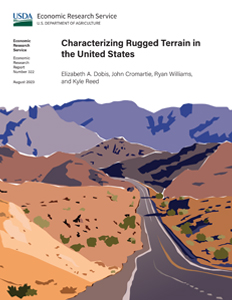Characterizing Rugged Terrain in the United States
- by Elizabeth A. Dobis, John Cromartie, Ryan Williams and Kyle Reed
- 8/1/2023
Overview
Mountains and other topographic features with variable elevation provide benefits to residents and visitors but may also impose barriers to travel and restrict economic development. ERS researchers develop two national representations of relative topographic variability for census tracts: the Area Ruggedness Scale characterizes overall ruggedness and the Road Ruggedness Scale characterizes ruggedness along roads. To understand variation of characteristics by terrain ruggedness ERS researchers analyze population, population density, and income across road ruggedness categories, rurality, and regions in the United States. ERS researchers find that as land becomes more rugged, population density decreases, more people live in rural locations, and more rural residents live in low-income census tracts. Ruggedness is distinct from rurality but in locations that are both highly rugged and rural, unique challenges may arise.
Errata: On September 21, 2023, the shading in figure 4 was corrected. This change clarified the region of five counties in southeastern Maine. The error occurred during visualization of the counties and does not affect anything else in the report.
How to Cite:
Dobis, E. A., Cromartie, J., Williams, R., & Reed, K. (2023). Characterizing rugged terrain in the United States (Report No. ERR-322). U.S. Department of Agriculture, Economic Research Service. https://doi.org/10.32747/2023.8134137.ersDownload
-
Entire report
Download PDF -
Report summary
Download PDF

